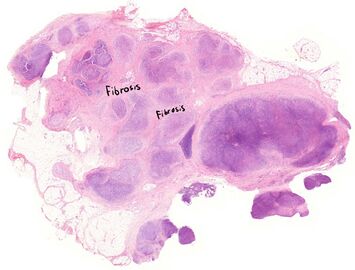19. Hodgkin lymphoma: Difference between revisions
(Created page with " '''Staining''': HE '''Organ''': Lymph node '''Description''': The basic structure of the lymph node is lost. Darker, basophilic regions are separated by brighter zones made up of fibrosis. Compared to the slides of most other lymphoid neoplasms are very few of the cells in these basophilic regions tumor cells. The tumor cells are surrounded by a background of reactive inflammatory cells –healthy cells that react to the tumor cells. The characteristic cell type f...") |
No edit summary |
||
| (2 intermediate revisions by the same user not shown) | |||
| Line 1: | Line 1: | ||
[[File:Hodgkin lymphoma - overview.jpg|thumb|Overview|355x355px]]'''Staining''': HE | |||
'''Staining''': HE | |||
'''Organ''': Lymph node | '''Organ''': Lymph node | ||
| Line 9: | Line 8: | ||
The basic structure of the lymph node is lost. Darker, basophilic regions are separated by brighter zones made up of fibrosis. | The basic structure of the lymph node is lost. Darker, basophilic regions are separated by brighter zones made up of fibrosis. | ||
Compared to the slides of most other lymphoid neoplasms are very few of the cells in these basophilic regions tumor cells. The tumor cells are surrounded by a background of reactive inflammatory cells –healthy cells that react to the tumor cells. | Compared to the slides of most other lymphoid neoplasms are very few of the cells in these basophilic regions tumor cells. The tumor cells are surrounded by a background of reactive inflammatory cells –healthy cells that react to the tumor cells.[[File:Hodgkin lymphoma - RS cell.jpg|thumb|The pathognomic Reed-Sternberg cell|335x335px]]The characteristic cell type for Hodgkin lymphoma is the ''Reed-Sternberg cell''. These large cells have large nuclei and prominent nucleoli and are tumor cells. They most frequently contain two or three nuclei. They may be mononuclear, in which case they’re called simply ''Hodgkin cells''. Binuclear Reed-Sternberg cells appear to have a mirror axis, giving them the name “mirror cells”. | ||
The characteristic cell type for Hodgkin lymphoma is the ''Reed-Sternberg cell''. These large cells have large nuclei and prominent nucleoli and are tumor cells. They most frequently contain two or three nuclei. They may be mononuclear, in which case they’re called simply ''Hodgkin cells''. Binuclear Reed-Sternberg cells appear to have a mirror axis, giving them the name “mirror cells”. | |||
The reactive background cells are lymphocytes, plasma cells and eosinophils. | The reactive background cells are lymphocytes, plasma cells and eosinophils. | ||
| Line 20: | Line 17: | ||
* Not well known. <abbr>EBV</abbr> plays a role | * Not well known. <abbr>EBV</abbr> plays a role | ||
[[File:Hodgkin lymphoma - high magnification.jpg|thumb|Note that the small cells in the background are not tumor cells but reactive immune cells.|315x315px|none]] | |||
[[File:Hodgkin lymphoma - high magnification.jpg | |||
[[Category:Pathology 2 - Histopathology slides]] | [[Category:Pathology 2 - Histopathology slides]] | ||
Latest revision as of 13:48, 7 July 2024

Staining: HE
Organ: Lymph node
Description:
The basic structure of the lymph node is lost. Darker, basophilic regions are separated by brighter zones made up of fibrosis.
Compared to the slides of most other lymphoid neoplasms are very few of the cells in these basophilic regions tumor cells. The tumor cells are surrounded by a background of reactive inflammatory cells –healthy cells that react to the tumor cells.

The characteristic cell type for Hodgkin lymphoma is the Reed-Sternberg cell. These large cells have large nuclei and prominent nucleoli and are tumor cells. They most frequently contain two or three nuclei. They may be mononuclear, in which case they’re called simply Hodgkin cells. Binuclear Reed-Sternberg cells appear to have a mirror axis, giving them the name “mirror cells”.
The reactive background cells are lymphocytes, plasma cells and eosinophils.
Diagnosis: Hodgkin lymphoma
Causes:
- Not well known. EBV plays a role

